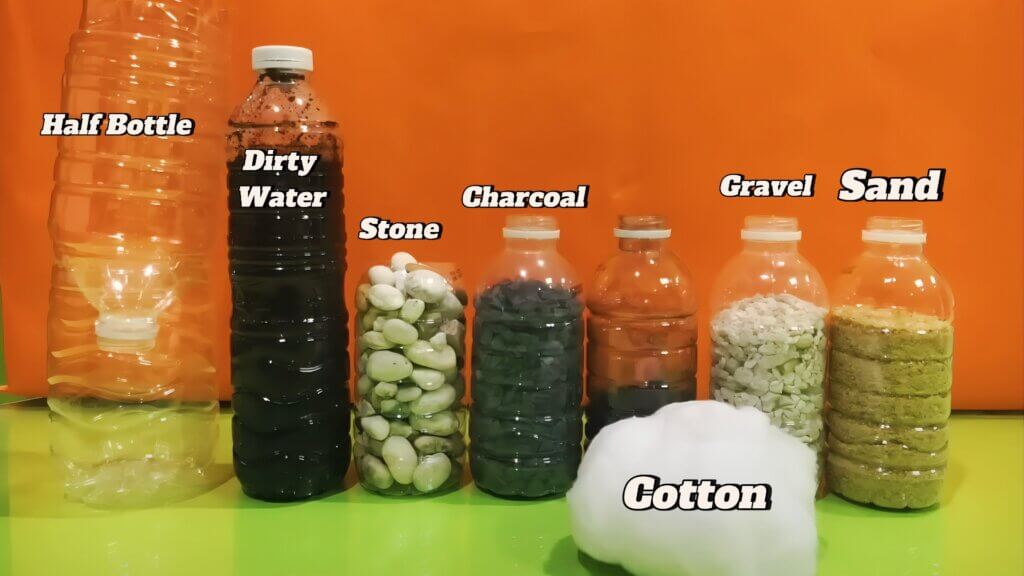In the wilderness, clean water is vital for survival. Mastering water filtration skills can be a lifesaver, ensuring safe drinking water in challenging environments. Learn how to construct a DIY water filter and other purification methods to thrive in nature.
Key Takeaways:
- Water filtration is essential for survival in the wild, removing harmful contaminants.
- DIY filters can be made using natural materials like sand, gravel, and charcoal.
- Regular maintenance is necessary to ensure the filter’s effectiveness.
- Boiling, solar disinfection, and purification tablets are alternative water purification methods.
- Understanding water filtration is critical for wilderness survival.
Understanding the Basics of Water Filtration
Water filtration is the process of removing harmful substances from water. This can include bacteria, viruses, algae, fungi, minerals, man-made pollutants, and other contaminants. The goal is to produce water that is safe for human consumption.
In survival situations, water filtration is of utmost importance. It can mean the difference between life and death. Drinking unfiltered water can lead to a host of health problems, including dehydration, diarrhea, and even more serious diseases like cholera and typhoid fever.
The basic principles of natural water filtration involve using various layers of natural materials to filter out impurities. This can include sand, gravel, and charcoal. Each layer plays a crucial role in the filtration process, trapping different types of contaminants as the water passes through.
| Layer | Role |
|---|---|
| Sand | Traps larger particles |
| Gravel | Prevents sand from clogging |
| Charcoal | It absorbs chemicals and odors |
Identifying Water Sources in the Wild
When in the wild, identifying a reliable water source is the first step towards ensuring your survival. Common water sources include rivers, streams, lakes, and rainwater. Snow and ice can also be melted for water, but this requires additional energy and resources.
Identifying safe and unsafe water sources is crucial. Clear, flowing water is generally safer than stagnant water, but it should still be filtered before consumption. Stagnant water can harbor harmful bacteria and parasites, making it unsafe to drink without proper treatment.
The dangers of consuming unfiltered water cannot be overstated. It can lead to a host of health problems, including diarrhea, vomiting, and severe dehydration. In extreme cases, it can even lead to life-threatening diseases like cholera and dysentery.
Materials Needed for a DIY Water Filter

Building a DIY water filter requires a few basic materials. These include a container (like a plastic bottle or a hollow log), sand, gravel, charcoal, and a piece of cloth or bandana. Each of these materials plays a crucial role in the filtration process.
The container serves as the housing for the filter. The sand, gravel, and charcoal act as the filtration layers, each trapping different types of contaminants. The cloth or bandana is used to prevent the filtration materials from escaping the container.
In the wild, you may need to improvise. For instance, if you don’t have a plastic bottle, you could use a hollow log or a large leaf rolled into a cone. Water sources are common places to find sand and gravel, and wood can be burned to make charcoal.
Step-by-Step Guide to Building a Water Filter
Building a water filter in the wild is a straightforward process. Here’s a step-by-step guide:
- Cut the bottom off your container (if using a plastic bottle).
- Place the cloth or bandana at the neck of the container to prevent the filtration materials from escaping.
- To create the filter, start with a charcoal layer, then add sand, and finish with gravel.
- Repeat the process until the container is filled.
- Pour water into the filter, and collect the filtered water from the bottom.
Ensuring the filter works effectively is crucial. The water should be clear and free of particles after filtration. If not, you may need to add more layers or adjust the thickness of each layer.
Common issues with DIY filters include clogging and slow filtration. If the filter is clogged, try removing some of the filtration materials. If the filtration process is too slow, you may need to add more gravel to prevent the sand from compacting.
Testing the Filtered Water
After filtration, it’s important to test the water’s cleanliness. This can be done by checking the clarity of the water and smelling it. The water should be clear and odorless. If it’s not, it may need to be filtered again.
Signs that the water is still unsafe to drink include cloudiness, a foul smell, or a strange taste. If any of these signs are present, do not drink the water. It may need to be boiled or treated with purification tablets to ensure its safety.
If the water is not clean after initial filtration, additional steps may be necessary. This could include boiling the water, using purification tablets, or building a more complex filter.
Maintaining and Improving the DIY Water Filter
Maintaining the filter is crucial for its continued effectiveness. This includes cleaning the filter regularly and replacing the filtration materials as needed. The filter should be cleaned after every use to prevent the buildup of contaminants.
Improving the filter’s effectiveness can be achieved by adding more layers or increasing the thickness of each layer. Additionally, using a finer cloth or bandana can help trap smaller particles.
Knowing when to rebuild or replace parts of the filter is also important. If the filter is no longer effective or if the filtration materials are heavily contaminated, it may be time to rebuild the filter.
Additional Methods for Purifying Water in the Wild
While filtration is an effective method for purifying water, it’s not the only method. Boiling is another common method used in the wild. It involves heating the water to a rolling boil for at least one minute to kill any harmful bacteria or parasites.
Solar disinfection is another method that can be used in sunny conditions. It involves filling a clear plastic bottle with water and leaving it in direct sunlight for several hours. The UV rays from the sun kill harmful organisms in the water.
Purification tablets or drops can also be used to purify water. These products contain chemicals that kill harmful organisms in the water. They’re lightweight and easy to carry, making them a good option for backpackers and hikers.
Case Studies of Water Filtration in Survival Situations
There are numerous real-life examples of people using DIY water filters in survival situations. For instance, during the 2010 earthquake in Haiti, many people relied on homemade water filters to access clean water. These filters were often made from local materials, including sand, gravel, and charcoal.
These case studies highlight the importance of understanding water filtration in survival situations. They also provide valuable lessons, such as the importance of maintaining the filter and the need for multiple purification methods.
Learning from these examples can help you better prepare for survival situations. It’s not enough to just know how to build a water filter; you also need to understand how to use it effectively and how to adapt to different situations.
Conclusion
Water filtration is a crucial survival skill that can mean the difference between life and death in the wild. By understanding the basics of water filtration and learning how to build your water filter, you can ensure you always have access to clean, safe water.
But learning is just the first step. Practice is equally important. Before venturing into the wild, practice building and using a water filter at home. This will help you become more comfortable with the process and better prepared for real-life survival situations.
Remember, water is life. And in the wild, a reliable source of clean water can be your most valuable asset. So take the time to learn and practice this essential skill. Your life may depend on it.
Frequently Asked Question
What materials can I use to build a water filter in the wild?
Common materials for a makeshift water filter include rocks, sand, charcoal, and cloth. These can be layered to create a simple filtration system.
How do I construct a basic water filter without any specialized tools?
To build a primitive water filter, find a container, cut the bottom, add layers of coarse and fine materials (like gravel, sand, and charcoal), and allow water to pass through the layers, collecting in a separate container.
Can I use any type of charcoal for water filtration?
Ideally, use activated charcoal, but in the wild, you can make your own by heating wood in a fire until it turns to charcoal. Crush it into a powder before adding it to your filter layers.
Is it safe to drink water filtered through natural materials in the wild?
While basic filtration methods can improve water quality, they may not remove all contaminants. Boiling the filtered water is an additional step to ensure its safety, killing harmful microorganisms.
How often should I replace or clean the materials in my improvised water filter?
Regular maintenance is crucial. Check and clean your filter components, especially the cloth and charcoal, to prevent clogging and maintain effective water filtration. Replace materials if they become overly saturated or contaminated.

Ross Walters, an Electrical supplies and Water Appliances specialist, shares his extensive expertise on top platforms. With a focus on empowering professionals and enthusiasts, Ross delivers up-to-date insights and practical advice. His commitment to staying abreast of industry trends establishes him as a trusted source for navigating the complexities of electrical systems and water appliances.

